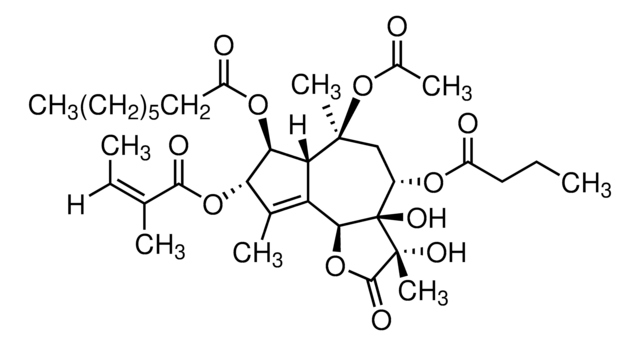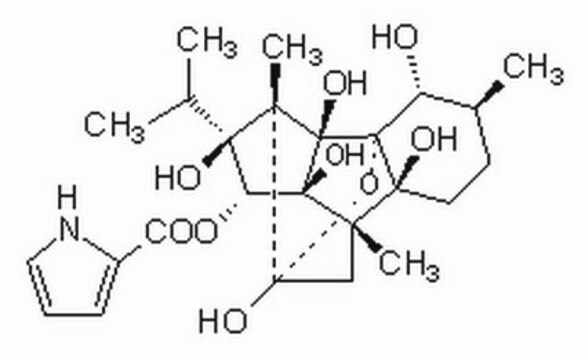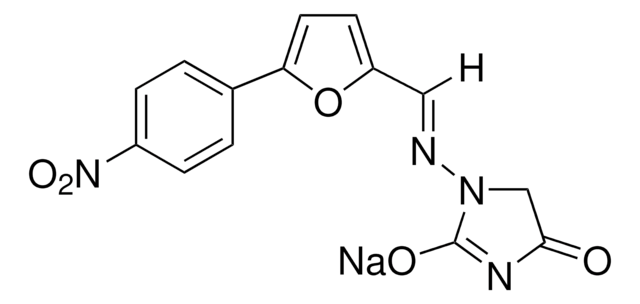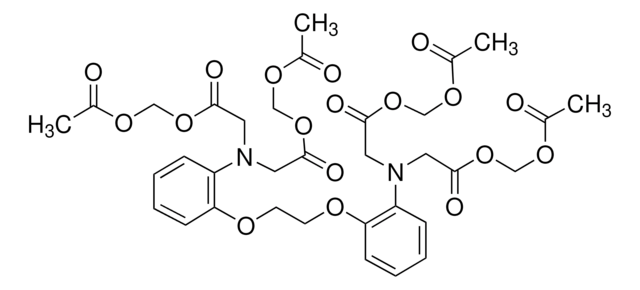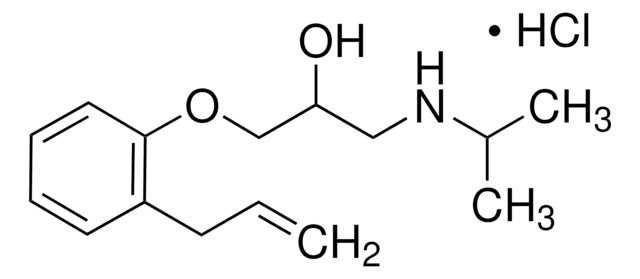Wszystkie zdjęcia(1)
Kluczowe dokumenty
About This Item
Wzór liniowy:
C28 H50 N2 O2
Numer CAS:
Masa cząsteczkowa:
446.71
Numer MDL:
Kod UNSPSC:
12352200
Identyfikator substancji w PubChem:
NACRES:
NA.77
Polecane produkty
Formularz
film
kolor
colorless
rozpuszczalność
DMSO: soluble
Warunki transportu
dry ice
temp. przechowywania
−20°C
ciąg SMILES
[H][C@@]12CCCCCC[C@@]3([H])CCCN4CC[C@@]([H])(CCCCCC[C@]5([H])CCCN(CC1)[C@@]5([H])O2)O[C@@]34[H]
InChI
1S/C28H50N2O2/c1-3-7-15-25-17-21-30-20-10-14-24(28(30)31-25)12-6-2-4-8-16-26-18-22-29-19-9-13-23(11-5-1)27(29)32-26/h23-28H,1-22H2/t23-,24+,25-,26-,27+,28+/m1/s1
Klucz InChI
PQYOPBRFUUEHRC-HCKQMYSWSA-N
Opis ogólny
Synthetic form of the macrocyclic bis-1-oxaquinolizidine isolated from the Okanowan marine sponge.
Działania biochem./fizjol.
Xestospongin C is a potent, reversible and membrane-permeable blocker of IP3-mediated Ca2+ release (IC50=358 nM).
Xestospongin C is a selective, reversible and membrane-permeable inhibitor of IP3 receptor. Reversibly blocks bradykinin- and carbamylcholine- Ca2+ efflux from the endoplasmic reticulum stores.
Cechy i korzyści
This compound is featured on the InsP3/Ryanodine Receptors page of the Handbook of Receptor Classification and Signal Transduction. To browse other handbook pages, click here.
Opakowanie
Package under nitrogen, tightly sealed.
Ta strona może zawierać tekst przetłumaczony maszynowo.
Kod klasy składowania
11 - Combustible Solids
Klasa zagrożenia wodnego (WGK)
WGK 3
Temperatura zapłonu (°F)
Not applicable
Temperatura zapłonu (°C)
Not applicable
Środki ochrony indywidualnej
Eyeshields, Gloves, type N95 (US)
Wybierz jedną z najnowszych wersji:
Masz już ten produkt?
Dokumenty związane z niedawno zakupionymi produktami zostały zamieszczone w Bibliotece dokumentów.
Klienci oglądali również te produkty
Shaily Malik et al.
Frontiers in molecular neuroscience, 10, 404-404 (2017-12-21)
Human immunodeficiency virus-1 (HIV-1) infection compromises the central nervous system (CNS) in a significant number of infected individuals, resulting in neurological dysfunction that ranges from minor cognitive deficits to frank dementia. While macrophages/microglia are the predominant CNS cells infected by
Hirofumi Morihara et al.
PloS one, 12(12), e0189948-e0189948 (2017-12-22)
Excessive levels of reactive oxygen species (ROS) and impaired Ca2+ homeostasis play central roles in the development of multiple cardiac pathologies, including cell death during ischemia-reperfusion (I/R) injury. In several organs, treatment with 2-aminoethoxydiphenyl borate (2-APB) was shown to have
Martin Prince Alphonse et al.
Journal of immunology (Baltimore, Md. : 1950), 197(9), 3481-3489 (2016-10-04)
Kawasaki disease (KD) is a multisystem vasculitis that predominantly targets the coronary arteries in children. Phenotypic similarities between KD and recurrent fever syndromes point to the potential role of inflammasome activation in KD. Mutations in NLRP3 are associated with recurrent
D B van Rossum et al.
The Journal of biological chemistry, 275(37), 28562-28568 (2000-07-06)
The mechanism for coupling between Ca(2+) stores and store-operated channels (SOCs) is an important but unresolved question. SOC-mediated Ca(2+) entry is complex and may reflect more than one type of channel and coupling mechanism. To assess such possible divergence the
Wenbin Zhong et al.
Nature communications, 7, 12702-12702 (2016-09-02)
Metabolic pathways are reprogrammed in cancer to support cell survival. Here, we report that T-cell acute lymphoblastic leukemia (T-ALL) cells are characterized by increased oxidative phosphorylation and robust ATP production. We demonstrate that ORP4L is expressed in T-ALL but not
Nasz zespół naukowców ma doświadczenie we wszystkich obszarach badań, w tym w naukach przyrodniczych, materiałoznawstwie, syntezie chemicznej, chromatografii, analityce i wielu innych dziedzinach.
Skontaktuj się z zespołem ds. pomocy technicznej